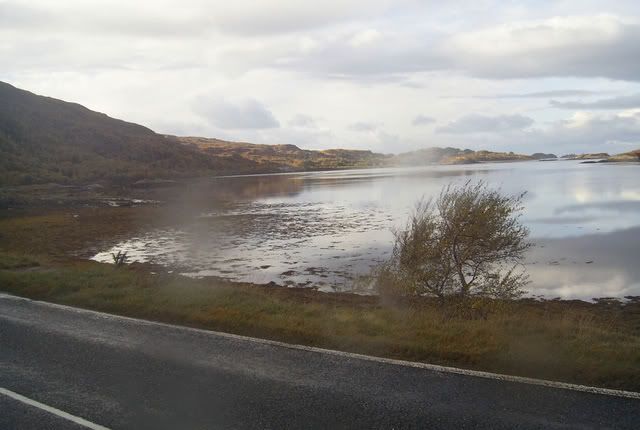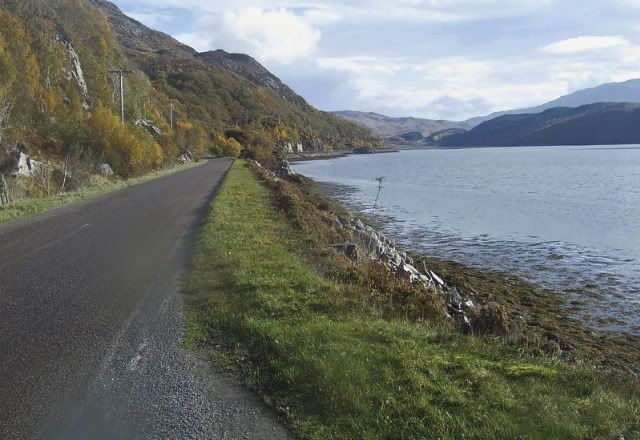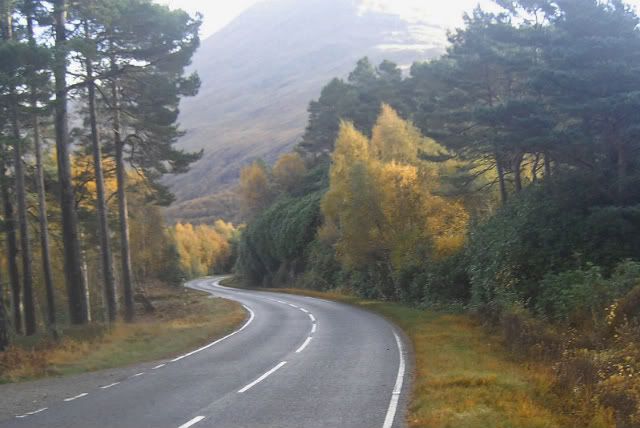305 Miles
Included:
DVLA Best Biking Route #3 Heights of Kinlochewe/Glen Docherty
DVLA Best Biking Route #2 Bealach Na Ba (The Pass of the Cattle)
The digital clock blinked over. It read, 6.32 am. I'd been awakened by the sound of the landlady’s shoes clattering backwards and forwards on the wooden floor of the room above. I lay in the dark, still half asleep, listening to the busy footfalls and also to another sound: to the spattering of gusty rain upon the windowpanes.
I don’t mind the rain. I’ve never minded it. And I’ve never minded riding in it either. Of course, I get a little anxious about the possibility of having a slide or of not being able to see properly through a wet visor but that is just background stuff. Anxiety is just part of the fabric of life and I've learnt to deal with it as it comes. I try not to let it become a barrier in my mind.
In fact, I positively enjoy the rain. It’s very egalitarian. It doesn’t mind who or what it falls on. And it obliterates boundaries and distinctions. The rain has something of the quality of the imagination about it: on a rainy day every element, every house, tree, hill, river, road, sign, person, animal, every thing is seamlessly integrated into the single predominating fact of wet weather. It's hard to make judgements about anything in the rain, I find. And because it is quite unconcerned about all our irritable demands and preferences it's a good tutor - it gives lessons about accepting some of the more intractable facts of human existence. We can grumble about it if we like but we can’t escape it. Much better to think of it as a gift.
Nobody else appeared to be staying at the B&B and I found that I would be eating alone in the guest's dining room that morning. The landlady's family were at breakfast in the adjoining kitchen. Occasionally, their muffled voices drifted past the door and across the dining room to where I was sitting. That kitchen door was a real and symbolic barrier, a clear demarcation between 'them' and 'us,' the public and the private: two very separate worlds but in distrubingly close proximity. As the voices rose and fell, I felt I was evesdropping on something personal, even though I couldn't hear what they were saying. It was the tone, the easy familial manner. It was everything my journey was not.
While I waited for breakfast, I picked out a tall, paperback book from a nearby shelf. It was a book of tales told by local people and recorded by children from the Bettyhill Secondary School. On the jacket, the publisher’s blurb claimed that an oral storytelling tradition was alive and well up here in Northern Scotland. If I’d had more time I would have enquired about that. Storytelling is such a fascinating and fundamental skill. It has a position of importance in so many traditional cultures.
Over the years I’ve come to believe that the lives we live are entirely metaphorical. Everything we see and hear and smell and touch and taste is, in one sense, a sensory delusion, a creation of our busy brains, a metaphor for whatever signals we are receiving from the ‘world outside’ (wherever and whatever that might be). Language too, through which we attempt to define and capture and communicate these metaphorical sensations, is, itself, just another huge system of metaphors. And within these systems we live out our days, weaving a vast web of stories. We tell ourselves and others endless tales about the world around us and the world within us. And through those tales we come to create our understanding of everything there is - and a lot more besides.
In another sense, the world we live in is very real, metaphorical or not. The question is, does our understanding of it constitute knowledge?
No-one has a particular handle on the truth, it seems to me. Those who believe they have, are wilfully and anxiously fixing stories in their minds. And when our stories are fixed they come to acquire a peculiar pseudo-reality of their own, a reality that seems more real than the always surprising, always upsetting world around us and in us. Religions do that, political philosophies, systems of morals, aesthetic creeds, ideologies of all kinds. We all do it. It’s understandable. We’re insecure. We are all insecure all the time – if we are being real. There can be no security in an ever-changing, chaotic world. The task is to recognize what we are doing - fixing things, and why we are doing it.
So in our every encounter with the confusing and unpredictable we seek stability. We search for clarity and certainty. Clarity reassures us and gives us a temporary sense of control, but the price we pay for clarity is fixity. And once our thoughts have become fixed into dogmatic systems of any sort, we begin to insist that our stories - poor, sad, coffined things - belong to that great class of items we call, ‘The Truth.’ And then we begin to demand that others accept them too.
Story-telling is a way of accessing the treasure-house of the unconscious, which, in reality, is almost everything we are. Our lives are so much greater than our routine thoughts. Quietly and secretly, the unconscious influences everything we see and hear and think and feel and do. I'm fascinated by the old brain which still functions within us as it has done for millions of years. And yet we pay it so little heed. Over time, I’ve come to see the conscious mind as just the tiniest fragment of our whole selves. It is like a comet, bright and captivating, flashing through the skies. Beyond its orbit, glimpsed at but never truly seen, is the vast galaxy of the unconscious.
Journeys, like stories, are ways of accessing the treasures of the unconscious. Like real stories, journeys are constantly changing, flowing, moving, transmuting themselves into something else. They are full of surprises and discoveries. They challenge us at every turn. Travelling through an unknown landscape provokes new reactions, new thoughts. It enlivens the senses and stimulates the imagination. It tests us constantly and challenges our tendency to hold on to the past and , even more, on to our ways of subding the past. It awakens the dead. It breaks up the baked, parched earth of our everyday thoughts. It shakes up all kinds of emotional sediment.
Real journeys, if undertaken mindfully and well (if treated as a great metaphor for our lives), can unshackle us from the thousand-and-one attachments (the thousand-and-one fixed stories) we have built for ourselves back home in our day-to-day living: attachment to things, to ideas, to sentiments, to beliefs, to our images of other people, to our images of ourselves.
But these thoughts are evening thoughts, not morning ones, and I can’t honestly say they went through my head as I sat in the breakfast room in the house in Tongue. I guess they were there, though, in the back of it (they are never that far away) as I flicked through the book of stories recorded and set down by the Bettyhill schoolchildren. I was getting impatient waiting for breakfast. The journey ahead had got me exited. And that was precisely because it offered me a way of becoming something other than I already was - and I'd begun to realise that what I was had been getting quite narrow and repetitive of late.
So there you have it! If you are of a sceptical frame of mind, you might want to deconstruct all that and say that I’m just an impatient bugger! You might! And I wouldn’t dream of contradicting you.
“Rather you than me!” said the landlady walking past the SV on her way to the back garden as I stood zipping myself into the last of my gear. And I knew what she meant. The rain was just an intermittent drizzle but it gave no sign of abating, and the wind was whisking dead leaves chaotically all over the yard. Clouds like raw fleece were hanging low from horizon to horizon.
I knew what she meant and I agreed with her: yes, I thought, rather me than you. I was looking forward to today. Solitary journeys gradually open out the senses and the imagination till the traveller in us becomes awakened and perfectly receptive to everything around him. I had just begun to reach that point in my own journey. The day and the journey had already become so much more than just the activity of moving from place to place and the practical tasks that invovled.
The road out of Tongue wound steeply downhill into the valley bottom - down, as I discovered, towards the Kyle of Tongue, a broad saltwater inlet, and down to the causeway across the Kyle, which cut short an eight mile journey around the bay. I was still heading westwards along the A838 for Durness, the next town of any size and the last town before my road turned south and before the coastline turned decisively south not long after. So, Durness, it was - not that I had much choice in the matter.
From Tongue to Durness is about 12 miles as the crow flies, but about 30 by road – because the next sea inlet, Loch Eribol, has no convenient causeway to shorten the route and the A838 has no choice but to follow it all the way round. In those thirty miles the A838 meets only two other ‘roads’ - both tiny and both unclassified, mere surfaced tracks. Both loop back on themselves and serve very local needs. Apart from the bumpy A838 there was no other significant road for fifteen, twenty, thirty miles.
Up on the mountain tops, the road shrank to a single track again. It wound about the hummocks here and there. And it had no clear notion of where it ended and where the land on either side began. Its edges wiggled about joyfully. ‘Organic’ might be an aesthetic word for it. ‘Bumpy’ would be a tactile one. The SV bounced along it with great ease. I bounced around on the SV and was happy.
At my next water stop I opened the map book for curiosity. The map around Tongue was largely blank, its primary features where the thin, blue lines of rivers and the blue streaks of lochs. Just three red roads divided this land into three simple segments. The few villages marked were just names, letters on a page. There was almost nothing else. Then I turned back the pages of the book to where my own home town in Hertfordshire (mapped on the same scale) lay at the centre of a dense and chaotic spider’s web of roads, a filigree of tiny lines, threading together hundreds of towns and villages. The villages were sometimes so close together that the mapmakers had had trouble marking in all their names. This was my home. I turned back the page, then looked around me. All this emptiness is thrillingly disturbing to a lowland Englishman.
Beyond the Kyle of Tongue the mountains rose high again, brown and baggy, and the clouds descended. The air was wet and misty. The deep, peaty soil was jet black. Everywhere there was standing water. And the drizzly rain fell. I could see for maybe four hundred yards in each direction, then nothing, just a blank and ragged wall of greyness. This might have been all the universe there was, just half a mile of wetness, a tiny seamless world of gloom and wetness: land, loch, air and sky. The sun had gone elsewhere, leaving not even an afterglow among the clouds. There was not another human being in all the world.
But there were sheep! – lots of them: munching their way through the wetlands, fantasising greedily about great billows of grass (you could see it in their eyes), whole mountainsides of wet straggly grass. They jogged along the road, or across the road, or into or out of the road, running for security, pressing their bodies against one another in the impersonal huddling flock. And there, suddenly, straight ahead of me on the tarmac was a scrawny ewe, standing between two others and staring straight at me and stamping her front feet in warning. A lion among sheep! Destined, for sure, to become a leader of her kind! I’ve only ever seen a ewe do that once before, to defend her lamb against the attentions of a small, curious and terrified dog. I sounded the horn and her heroic stance melted away like the mist and she was running back to the hills with her fellow ewes.
Then I saw my first red deer, a mature male with huge branching antlers standing alone in the mists, his flanks side-on and his great head turned towards me, gazing at me with that wonderful soft stare that only deer have. After that, I saw their red, sensitive bodies everywhere: lone adult males; roaming herds of females with this year’s young. On several occasions they crossed the road in front of me, flashing fear in those great, round, mournful eyes. Pheasants and woodcock and ptarmigan scattered as the sound of my engine. On a particularly bleak and empty bit of moorland, I rode by a sharp-eyed falcon resting on a sign. There was no question of who he was: he was the land-owner. He stared me out as he might have done any intruder into his domain.
The road about the long inlet of Loch Eribol was… well, long! And low, with wide panoramas all around. It made a welcome contrast to the shrouded hills. The valley floor was somehow still bright beneath the dense cloud cover. It felt like a homecoming, a return to humanity and social life. In all the 30 miles of travel so far that morning, I had passed two cars. And now, here, on the valley floor, I pulled over for a large tanker, bouncing merrily along the little road like something out of a child’s storybook. I was approaching Durness. Bungalows appeared, small outlying settlements not marked on the map. I knew when I had reached Durness itself even before I saw the sign because the road suddenly widened and acquired a white line.
Like other villages in these parts it was just a collection of homesteads scattered about the hills and cliffs. Every one of them was painted white. I had the impression of a lot of wire everywhere: fences, aerials, telephone cables, washing lines. It was a long village. It seemed to go on for ever. After a mile or two I began to get worried that I would find no petrol here. There was still a long way to go to Ullapool, my next decent-sized stop and my tank was half empty. Fortunately, as I rounded a bend, I recognised something: a ‘High Street!’ with some shops, a pub and a little wooden hut with two rusting pumps outside it. A large sign announced, ‘Scottish Fuels’. I pulled up. No-one was in the hut when I arrived but before I even had time to wonder what the protocols were, a small, wiry man was loping over the road towards me from the ‘SPAR’ grocery opposite.
“Fill her up, please,” I asked.
“Aye.”
“Bit grey this morning."
“Aye.”
I had to think about what to say next.
“I hear you have been having some very wet weather up here recently,” I tried.
“Aye.”
This conversation clearly wasn’t going to go very far. But then, I caught a hint of something stirring behind his eyes. There was a little shudder. I waited.
“Aye,” he said again, then, “We have that!”
Progress! Of a kind.
“I’ve been seeing a lot of flood warning signs on the road.”
“Aye.”
The silence settled down around us.
The pump was a wonderful piece of machinery. It was the most earnest petrol pump I had ever encountered. It rattled and groaned and juddered. The dials turned round reluctantly with agonising slowness. Once or twice they stammered and threatened to seize up altogether. It seemed to me that the pump’s mechanism and its operator’s mind belonged in the same universe.
“How far is it to Ullapool from here?” I enquired, more to fill in the silence than anything else.
“Aye,” he said, thoughtfully.
This time, I knew I had to wait. The silence elongated. Then...
“Fifty miles,” he ventured.
“Ah! Right! Thank you.”
“Aye!”
In all this time, the genial smile that played around his mouth and eyes never left him. This was clearly his best friendly manner. So this was what was meant by ‘a dour Scot!’
The tank, at last, was full. He withdrew the nozzle and I reached for my wallet to pay him. But no! With a thoughtful expression (and with hawk-like tenacity) his eyes continued to watch the petrol level in the top of my tank. It slowly dropped. When he was satisfied it had fallen far enough, he returned the nozzle to the opening once more, and squeezed the trigger gently. The tank absorbed another trickle of fluid. The nozzle was again withdrawn. And again the procedure was repeated. I watched fascinated. Four times in all, he managed to squeeze a little extra petrol into the tank.
It is possible that he was seriously concerned that I shouldn’t run out of fuel on these long and empty roads. It is possible. On balance, though, I think I had just met my first ‘canny Scot.’ I was learning a lot today. He took my money and counted out my change with the same thoughtful, earnest kind of precision with which he had filled my tank. I said goodbye, and strapped on my lid. I watched as he loped back across the road and with all sincerity (and amusement) quietly wished him well.
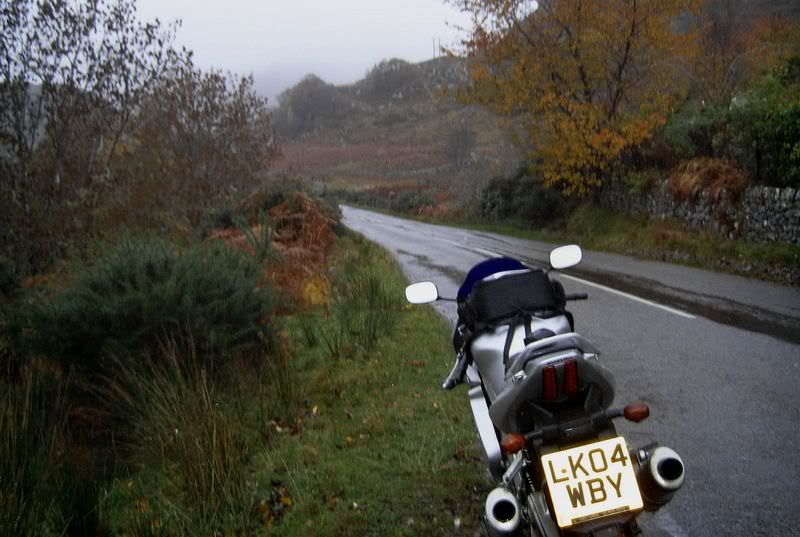
Outside Durness on the way to Ullapool
The A838 follows the shore of the Kyle of Durness for several miles and then turns south-west, until it hits the western coast. It cuts off the great rectangular peninsula of The Parph to the north, a massy wilderness of rock and bog and moor. Within its inhospitable 70 square miles there are only a handful of communities, a few tiny villages scattered along its south-western edge. But along the north-eastern edge is a little road.
When I was a child I grew fascinated with the thought that every road in the land, as distant and obscure as it seemed to be, was ultimately connected to every other road. Links to the warmth and security of human life ran everywhere, all the way down to my front door. Looking at the map, I realised for the first time that this is not true. This little north-eastern road, which takes busloads of tourists from a landing on the far side of the Kyle of Durness along the coast to Cape Wrath, can only be reached by ferry. It joins nothing and goes nowhere. The tourists come to see the gigantic black cliffs and the seabird colonies. And then they go home again. And the land is as empty as before.
The Vikings who once occupied the Highlands and Islands gave many of their names to local things. This place where the trourist busses go, they named Cape Hvraf, which, in their language meant ‘The Turning Point.’ In their journey across the wild North Sea from Norway they looked out for Cape Hvraf; it was their landmark, the place where they turned south in their small boats. They were heading for the Hebrides, two shattered arcs of islands, separated from the mainland by the churning waters.
I would like to have taken the trip up to Cape Hvraf/Wrath but I had no time for excursions. And in all likelihood the bus wouldn't have run much past the end of September, anyway. I had already turned south - a little earlier than those Dark Age Vikings but no less decisively And the idea made me aware again that I too had made a turning somewhere that morning: something had finally unshackled itself in my mind. I’d relaxed into the journey. Home, was now no longer down in Hertfordshire or even in some cosy B&B where I would spend the night. It was here. And it was now. Whatever happened, good or bad - this was it. I’d found my Hebrides. I unconsciously gave the bike a pat on the tank as though it were a horse - then glanced around me feeling foolish, in case someone (Who, for god’s sake?) had noticed.
The rain which had started out this morning as an intermittent light drizzle, was becoming heavier and more persistent. I was wearing a waterproof Dainese suit and a lightweight waterproof top over that. Between the two, they kept most of me perfectly dry. My gloves and boots were not so effective. I’d brought leather gloves with me: they were winter gloves that were warm but not that waterproof. My hands were now permanently soaked, and the evaporation factor meant that they were also cold. My boots were genuinely waterproof and warm but I was wearing them outside my trousers and they were loose around my legs at the top. Now and then, a particularly well aimed gust of rain had managed to find its way into the gap, so by now my feet were pretty wet too.
The treeless plains of Caithness and the almost treeless moors of north-west Sutherland were giving way to another new landscape. Individual stands of fir began to appear among the tumbled stones. Soon there were woods and plantations rising up the lower hillsides. I had entered the Assynt and Coigach region. If I’d had more time and the weather were kinder I would have stopped here and explored a little. This area is said to have some of the wildest and most beautiful scenery in all the Highlands. Given what I had seen already, I imagined it must be very special indeed. But I saw little of it, just patches of hillside emerging from the thick cloud or the occasional shadowy outline of a distant peak. I got little impression of how the land might look on a clear day but I did sense how remote and powerful it was, how fierce and very ancient.
About fifteen years ago, when I was planning to visit Scotland (one of several trips that never quite happened) I’d read up about the geology of this area. The mountains here in the North-West Highlands are all very old - very, very old indeed - worn down to their present modest size by millions of years of ice and water, cracked apart by alternating heat and cold. In their youth, their peaks were of such a height they would have dwarfed the Himalayas - so said one writer. I remember being very impressed by that. As an image it has stuck in my imagination like a stone in a horses hoof. I kept thinking of it now, conjuring up for myself a sense of their unfathomably great age. Their ancient life seemed to growl ferociously all around, in their craggy peaks and in their fragmented stones. It was a powerful place.
http://www.undiscoveredscotland.co.uk/l ... index.html
The crazy roads bumped along all morning: across moor and bog, round island-spattered lochs, past tiny hamlets and isolated farms, past rocky outcrops, through woods and through the roughest of rough pastures. Time and again, a coastal road having rounded a peninsula would suddenly turn eastwards and head on back inland. But at that point there would always be a junction and the start of another road to take me back westwards and round the next peninsual or spit of land.
And in a way that I had now come to expect these roads would change like shape shifters, suddenly and briefly acquiring two decent, narrow lanes and then just as suddenly shrinking back to one again.
And just when I'd thought I'd got the hang of this, the A835 completely took me by surprise. At one moment I was riding its narrow, bumpy tarmac and at the next I was cruising along on a broad, well-surfaced highway that, curve after curve, mile after mile, swept through the hills - magnificently. My speed rose to 60, which felt incredibly fast. It was a pleasure to be moving at a decent pace again and to be able to relax the concentration just a little.
The rain was persisted and the cloud cover was still heavy but the clouds had lifted just enough to let me see a few more details. With my attention freed from the road, I began to look about more. But as I turned each corner and came across one more sweeping loch, one more precipitous bluff, one more colourful pine forest, I have to admit that I was becoming just a bit jaded with it all and my attention and my enjoyment began to refocus on the ride.
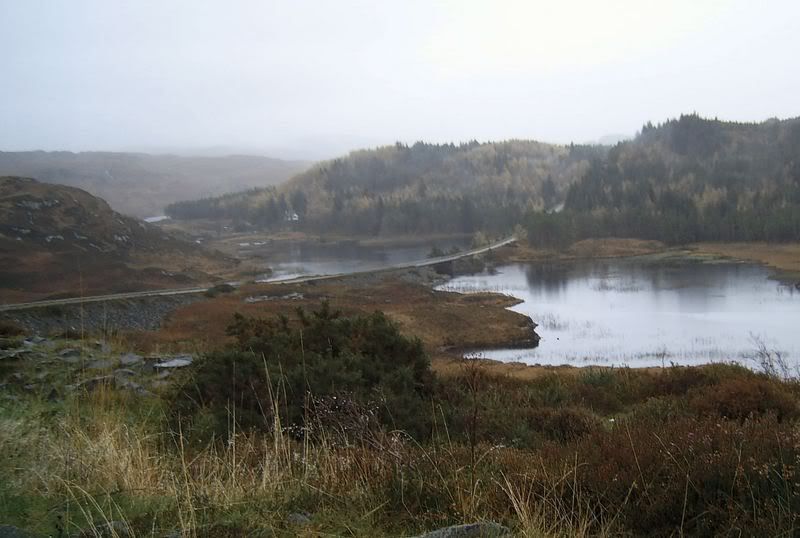
A view of the Assynt - Coigach National Park
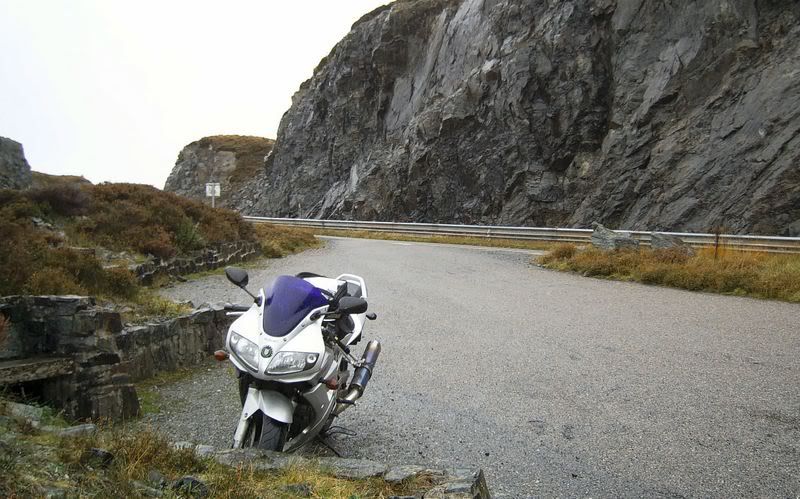
Taking a break in the Assynt - Coigach National Park
At 11.30 I rolled at last into Ullapool, the capital of Sutherland and the Western Highlands. It’s a practical little town on the side of a sea loch with a harbour and a fishing fleet. It is also something of a tourist trap. I parked up the bike, wrung the free water out of my gloves as though they were a couple of dish clothes and looked around for something to eat.
http://www.undiscoveredscotland.co.uk/u ... index.html
On my way down to the harbour area where I thought I might find a café I dropped into a Tourist Information Office to get a weather forecast for the rest of the day. I was having the beginning of a doubt as to whether there was any point persisting with my plan to follow the coast if the low cloud were going to prevent me from getting much sense of the land. The woman in the office was young, English and, of course, very friendly. (Is there no end to the sheer quantity of friendliness up here?) She checked the web for me and came back with the excellent news that the low cloud was moving south and should begin to clear into the afternoon. In my ever hopeful brain, I immediately translated this into - within a couple of hours it is going to turn into a fine, sunny day. That meant I could stick to my plan.
Now, though I’m optimistic, I’m not totally daft, so I did have some slightly more cautious thoughts as well. I considered, for example, the general reliability of weather forecasts, and what that interesting little phrase ‘should begin to clear’ might mean precisely. I gave consideration to these thoughts for all of - oh! fifteen seconds! For, though I am not without a sense of caution – in fact I would say that, temperamentally, I am quite a cautious person - I don’t generally let it interfere with my plans.
Don’t misunderstand me. I think caution is an admirable thing and can often be very useful. For example, being cautious in advance will generally prevent you from feeling too upset or disappointed when things don’t eventually work out they way you had hoped. Or again, admitting that you had considered all the issues carefully before walking alone in the Pre-Alps on a stormy day in October, can sometimes help you out when you are trying to explain to a French police officer why he should not recommend charging you lots and lots of money for the services of the Mountain Rescue Team. (Actually, on that occasion, it was the fact that Jean-Pierre, the team leader, was pissed out of his head and led his men up onto the wrong mountain while I found my way back home on my own, despite the inaccuracies in the municipal map, that swung the argument in my favour.)
I found a tourist café down by the harbour and parked up the bike in a corner of their small car park. Inside, the waitresses were extremely busy serving several coachloads of over-excited tourists. The cafe had wooden floors and almost no décor. I liked it. It had that cheerful, rough-and-ready feel of places that are perfectly happy for you to walk across their floor in muddy boots and shower fellow diners with water and twigs and caterpillars as you get out of your walking gear.
The waitress, however, wouldn’t allow me to order lunch because lunch could only be ordered from 12.00 and it was still only 11.53. Experience has taught me that in matters like this arguing is futile. The most I could hope to achieve was to occupy the next seven minutes in debate until I could legitimately demand some lunch. I was also very hungry and didn’t really want to hang around, so I submitted to the house rules and ordered (yet another) breakfast.
While I was waiting for it to be served several other coach parties arrived. The first was a group of earnest looking ‘walkers.’ It took me a moment to register what was odd about them. Almost every one of them was wearing perfectly clean and almost completely dry, heavy-duty wet weather gear. They must have walked no more than 25 yards from the coach that morning in a light, drizzly rain. Nevertheless, as they came in, they shook out their cagoules and rubbed their hands as though they had just arrived back from base camp in the Himalayas. The second party was a hoot. The moment they burst noisily through the door you could tell that they came from Lancashire. And it wasn’t just the accent. They instantly took over the place, pulling chairs and tables up directly in front of the fireplace to get at the heat and cutting it off from everyone else.
After I had eaten my rubberised eggs, burnt bacon and gristly sausages, I tried to sort out the stuff in my tank bag. I keep everything wrapped in polythene bags but it had all fallen out and was now wet: one of my local maps was a write off; the screen in my mobile phone had acquired a crystalline appearance from the little droplets of water now lodged under the glass (fortunately, it still appeared to be working) and a sopping wet bread roll had disintegrated over everything. Yuk! I stared at it for several minutes (and at my gloves which lay on the table looking every bit like a couple of dead moles) before I could summon the willpower to clean it all up, and dry out what I could.
I had just started getting back into my gear, ready to leave, when I felt a firm tap on my arm. Then, in a strong Lancastrian accent, a voice behind me demanded to know:
“What’s this thing for then?”
I turned around. A small, wiry woman in her sixties was pointing at my back protector.
“You’re a nosey cow!” shouted one of her male companions across the tables, cheerfully.
“I want to know.” She shouted back at him.
“Well!” she said, turning back to me, “What’s it for? What are you going to do with it?”
“Errr… I’m going to wear it on my motorcycle,” I said.
“A bike! Just a bike!” She looked genuinely affronted. “I thought you were going to jump out of a helicopter or something.”
“Not today.” I said.
“I thought you were a commando, or some bloke from the army.”
I just smiled and shook my head.
“How big is it?” she asked suddenly.
I had to think about that one for a moment.
“I bet it’s just one of those little 50cc things,” she said derisively.
And before I had recovered enough to make a reply, she added, “And I thought you were going to bring me a box of chocolates.”
She creased up laughing.
“Who’d want to buy you chocolates, you silly moo?” remarked another of her companions.
“A gentleman!” she retorted empathically, “Not like you.”
“What? You? You don’t know any ‘gentlemen.’”
“That’s as much as you know, Frank Hewitt,” she said, nodding smartly as though that clinched the matter.
(The ‘chocolates’ reference is to a long-running British TV advert: a man in black breaks into an isolated house after performing James Bond type stunts involving ropes and cliffs and helicopters and things, and leaves a box of chocolates anonymously on a woman’s bed. ‘Nuff said.)
For the next ten minutes, while I tried to get into my gear the whole restaurant was in uproar as the woman exchanged insults with me, her companions and, increasingly, with the other diners as well. I was reluctant to leave, it was so funny, but I had to get on, and the truth was, the woman was taxing my wits to the limit to keep up with her increasingly outrageous comments. Sadly, if I had any macho credibility left with her at all when I said goodbye, I blew it two minutes later when I dived back into the restaurant to retrieve my roll of soggy toilet paper which had rolled under one of the tables.
“Look!” shrieked the woman, still in full flow, “He’s scared himself stupid. He’s going to jump out of a helicopter after all!”
Maybe I need to take a course in delivering chocolates, or something.
Outside, the rain was tipping down again. I stood about under an awning and tried to get my hands back into my gloves – a clammy and sticky operation. A couple standing nearby made the usual ‘not very nice on a bike in weather like this’ remark, followed by a brief account of their rides out together in bygone days. They were part of yet another coach party, newly arrived. They came from Cumbria, they said. That surprised me. It shouldn’t have done, but I couldn’t help wondering why would people who live out their daily lives in Cumbria - the English Lake District - among some of the most beautiful mountain scenery in the world choose to come on holiday to look at more mountains? They just love ‘em I guess.
Over in the car park I found my bike completely boxed in by a coach. Back I went to the cafe yet again to find the driver. I asked him to move – just a few feet was all that was necessary. He was pretty huffy about it but he must have known. To be fair to him, though, there were now so many coaches in the small tarmac area next to the café that he couldn’t really have parked anywhere else.
I left Ullapool in a heavy drizzle and set off on the steeply inclined road. I was still in a good mood and looking confidently forward to the brilliant sunshine and stunning views I had been promised for the afternoon. I noticed that some of the heavy cloud clinging to the side of the fells was looking a bit raggedy now, as though it were already breaking up. Excellent!
The A835 beyond Ullapool began to turn inland and head off eastwards. It was an exceptionally good road and I was enjoying the easy riding but I was going west, not east and I was on the look out for a junction and my next road, the A832. The junction, when I found it was very dramatic. It overhung by a single enormous tree, so magnificent, even among all the other tall trees that lined this road, that I just had to stop and take a good look at it.
Beyond the junction, the early stretches of the A832 were stunning. The road ran along one side of a broad, flat river valley. Huge cliffs rose hundreds of feet from the valley floor on the far side of the river and disappeared into the clouds. Horizontal bars of mist clung to them here and there. On the side nearer the road, the slopes were gentler and covered with forests of pine and fir and birch. Trees pressed right up to the edge of the road. Through the haze of rain, their dripping leaves still managed to shimmer in orange and gold. They were almost luminous.
The valley was so beautiful it looked unreal. That sense of unreality no longer surprised me. So much of what I had seen today seemed almost unbelievable. The only thing that prevented this landscape from looking like some CGI dreamed up by Hollywood was that it was just too perfect (and in all this weather, a little uncomfortable too). The A832 was already living up to expectations. Further along and for much of its length, the map seemed to show that it was a real coast road that would keep me in sight of the sea. And then, beyond Gairloch, where it started to turn inland, it formed the route of the DVLA Best Biking Road #3, Loch Maree and Glen Docherty.
At the tiny hamlet of Dundonnell I was very pleased - and a little relieved - to find a couple of petrol pumps. The pumps were owned by a local hotelier. (Thank god for the tourist trade!) With all the hilarity in the café at Ullapool, I had forgotten to top up the tank there. The SV doesn't have a petrol gauge and I hadn't set the trip meter but I was sure that I was getting low. When I'd looked at the map back in the cafe the only town big enough to have petrol looked like Gairloch, which was still some forty miles further round the coast. I was beginning to think I would have to go back. Apart from the waste of time, that is something I hate doing - going back!
The road didn't disappoint. It kept to the coast, running high up on the cliffs round the bays and inlets. Gruinard Bay was wide and dramatic. Down in its grey waters, not far from the coast floats Gruinard Island, green, and idyllic and completely lethal. Landing there is prohibited. Back before the Second World War the government conducted some germ warfare experiments on the island and demonstrated successfully and conclusively that if you expose sheep to anthrax they die. Horribly!
Unfortunately the little anthrax critters rather liked Gruinard Island and decided to stay. They found an entrée into the local ecosystems and there they are to this day, alive and well and kicking, and thumbing their noses at the nearby human communities on the mainland. It seemed strange that anything quite so deadly as anthrax could be contained by such a narrow strip of water.
There were signs of other, more current, military activity in the neighbouring Loch Ewe. Someone with a lot of cash had built a series of very curious, industrial looking structures on platforms jutting out into the coastal waters from the base of the cliffs. A narrow track which turned off the main road and headed downhill had an equally business-like ‘No Entry’ sign beside it. This was accompanied by another sign which said simply 'NATO.' The word was written in bold red capitals (What is it about the military ego and red lettering?). No wonder there were good roads around here.
I was curious to see Gairloch, because I once knew someone who came from the town, though ‘knew’ might not be the right word: she was perhaps the most unknowable person I have ever met. She lived on a knifepoint, balanced precariously between a conventional middle-class existence, and a wild world of pure fantasy. Just being around her made me feel slightly queasy. But as strangely unstable as her world appeared to be - to me as an outisder - she seemed perfectly competent and capable living within it.
She had done me a couple of big favours, and for that, as well as for several other more intagible reasons, I allowed myself to be persuaded into staging a kidnapping for her. The subjects of the kidnapping were two very extraordinary cats. There is no question in my mind that the cats were either psycopathic or at least had severe personality disorders which required therapeutic help.
One of them, Sesame, was an obsessive predator. Four or five times a day I would clear the kitchen of dead birds, dead mice, dead voles and anything else she could get her teeth into. Occasionally she would take me unawares and deposit her kills onto my feet, presumably as some kind of offering. She drove me nuts. She was also very clumsy. A clumsy cat seems some kind of contradiction in terms, but Sesame was clumsy. Her body lacked any kind of energetic spark. She didn't lie down gracefully like other cats, she just sort of fell over and then stayed there without moving. When I first saw her she was sitting on a table and I thought she had been stuffed. The other cat – Linton, I think he was called - a ginger tom, was just very violent and unapproachable. He had a taste for blood – mostly mine. We didn’t get on.
Rather more psychopathic than the cats was the young woman who one day arrived at my door and announced that she was an officer from the cat’s home and wanted to see the little chartreuse and their ‘foster parent’. That they were ‘foster’ cats was news to me. I explained that their ‘foster parent’ was away for a while and I was looking after them until she returned. At that, the young woman turned a funny colour and went completely ape-dodo. The problem appeared to be that I was not an accredited cat-lover. I hadn’t been screened by the cat’s home and I therefore had no business looking after cats. When she finally calmed down, she informed me that she would be reporting this back to her manager who no doubt would be coming here to the house forthwith to collect the two unfortunate moggies and take them to a place of safety. Interestingly, she made no further effort to see them before she left.
That all led to the staged abduction (Ho Hum! What a tangle!). But right glad I was to see the back of them!
I was surprised to find that Gairloch was quite a substantial and lively town – by Highland standards, that is. The cat’s 'foster mother' had given me the impression that it was a tiny, introverted community where things went on that I was better off not knowing about.
Just beyond Gairloch the A832 abandoned the coast and did its turn inland. For several miles it degenerated into the worst road I had come across so far: narrow, broken and rutted but then recoverd itself as it reached the shores of Loch Maree. For the next twelve miles it closely followed the shoreline of the loch. This was the first part of the DVLA Best Biking Road #3. Along this stretch the road was broad and well-surfaced and was a total dream to ride: twelve miles of big sweeping curves and fast straights. It wasn’t a difficult, or technical road. It wasn’t particularly fast – though it could have been. It was beautiful and it was just sheer fun. The bike flew.
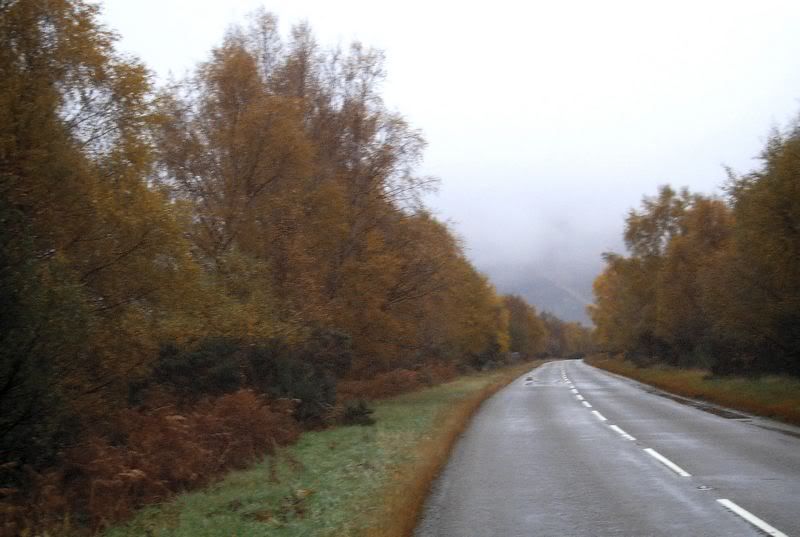
A short section of the Loch Maree Road
I followed the road eastwards beyond the loch and into Glen Docherty for several miles (Glen Docherty also forms part of the DVLA route) before turning back to pick up my westward-turning road, the A896, at the village of Kinlochewe. The A896 was another single-track road. Riding along the first few hundred yards of its length, I regretted the loss of the much better road I had just abandoned. But that feeling didn’t last long.
I’m getting rather bored at telling you about the beauty of this country because words can hardly express just how breathtaking it all is. Each new encounter slams into you with a physicality that knocks the breath out of your lungs and jars your senses This early section of the A896 took me straight into the Beinn Eigh National Park and into what was perhaps the most staggering landscape I have yet seen. And it was quite different from anything I had experienced before. This land was not gold, nor brown, nor yellow nor red, nor even green but the deepest and ruddiest copper colour I’d ever seen in my life. Everything around me was a blazing, burnished copper – every square inch of it. It glowed. And as it glowed, it roared like a furnace. I cannot really describe the impression it made.
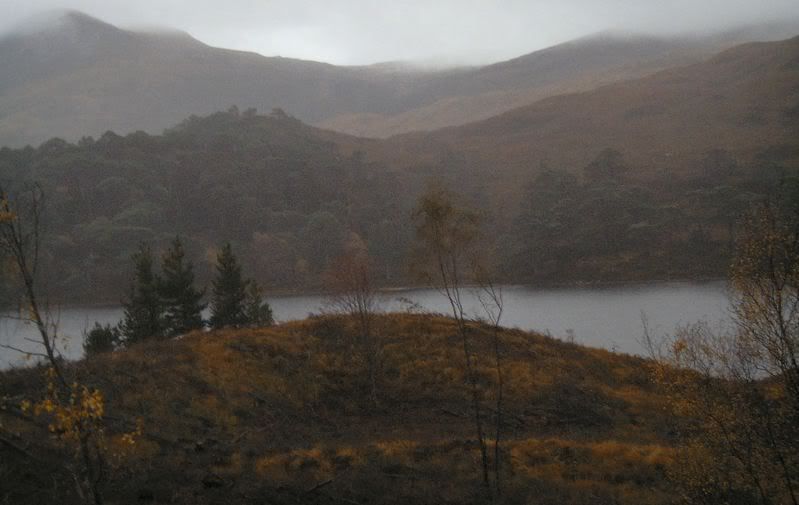
Beinn Eighe
I stopped over and over to take photographs but none of them do justice to the landscape. I've included some of them in the blog. They give a little idea of the place, but the colour values are all wrong and they can't capture the sense of immediacy and presence that the land had - you just drowned in it, it was so total. A small car in front of me kept stopping too. Its driver and passenger were a young couple. They were Middle-European I would guess, and had no English. He just waved his arms about him and looked at me mutely, while she ran back and forth with her hands over her mouth, gasping.
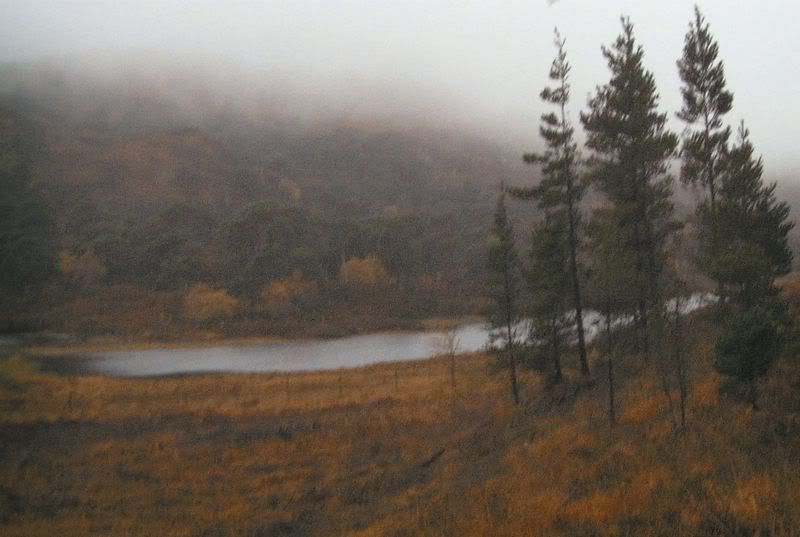
Another view of Beinn Eighe
It was stunning. Just simply that. Though I had a great need to hurry, I couldn’t. I stood by the bike for nearly half an hour, staring and clicking the camera. The woman suddenly called out and pointed. There, only about thirty yards in front of our eyes, completely camouflaged in this landscape and unseen by us for nearly five minutes was a huge male red deer gazing steadily in our direction. He was magnificent. Above and beyond him, in the darkening (and deepening) landscape, the low sun was diffusing a brilliant white glow through the westerly clouds. Those clouds hung from the mountain’s sides and boiled over the passes. This westward panorama was like a great glowing, steaming copper cauldron.
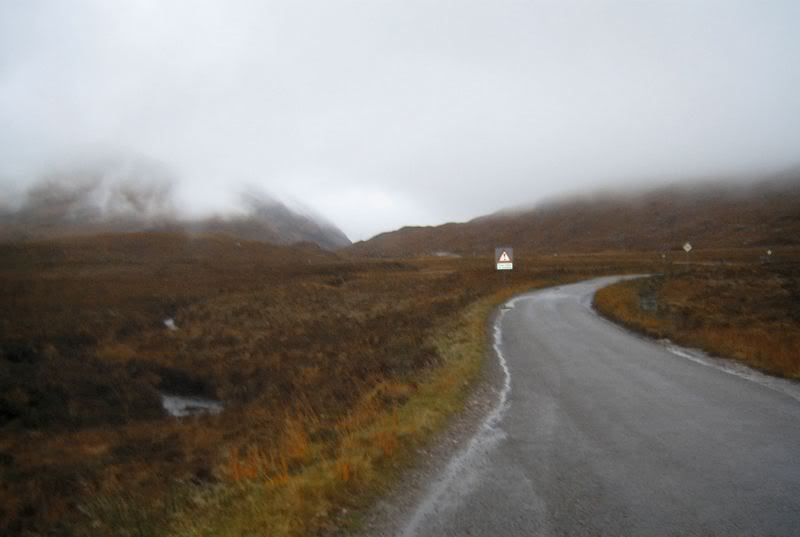
Beinn Eighe again
I eventually dragged myself away. I had to get on because there was one more DVLA Route, Route #2, to complete before nightfall. It had to be done today. If I didn’t get there before the sun went down I wouldn’t get another chance. It was already touch and go whether I would even get to it in time.
Beyond the copper land the scene kept rapidly changing but I was hardly aware of any of it. I caught just fleeting glimpses: mountain, coastal cliff, river valley, the broad and the flat, the rough and the hilly. My attention was focused on navigating the tricky little road ahead. And my imagination was wrung out: there is only so much of the extraordinary that you can take in one day. I was getting tired, too, and my thoughts were focused on getting to the DVLA Route, The Pass of the Cattle. Bealach na Ba it was called in Gaelic (or Bealach na Bo as the Tourist Office guidebook demanded, sniffily insisting that the name everyone used - including the locals - was incorrect). ‘The Pass of the Cattle!’ Coupled with its Gaelic name, it had a kind of archetypal and earthy ring to it.

I had planned to turn off onto the little unclassified road that followed the coast right round the Applecross peninsula before returning to the A896 over the Pass the Cattle, but now there was no time. That way would have put an extra 60 miles onto my journey. My one chance was to head directly for the Pass, ride its length (or as much of it as I dare before the light faded) and then return back over it to my starting point. I put my head down and went for it, without stopping to look or think. I found the turning, passed a sign which carried a multitude of warnings ('road not suitable in winter conditions, not suitable in rain, not suitable for inexperienced drivers'), and headed up to the pass without slackening speed.
http://www.undiscoveredscotland.co.uk/a ... index.html
The rough little road crossed a river over a rattly bridge then wasted no time in climbing the hillside opposite. It rose steeply, then more steeply still. A drop appeared to my left almost immediately, giving views across the shallow, rock-strewn Lock Kishorn and the sea loch beyond. The road was not easy to follow. The evening was drawing in quickly and the best light was already gone. Then the rain began to come down hard. Big droplets were running over my visor. The road, as narrow as they come, now twisted sharply about the hillside. The thick grass on either side encroached upon its surface. I turned a corner and there ahead of me was a misty bluff. A sheer wall of rock rising hundreds of feet from the valley floor. And then another on the far side.
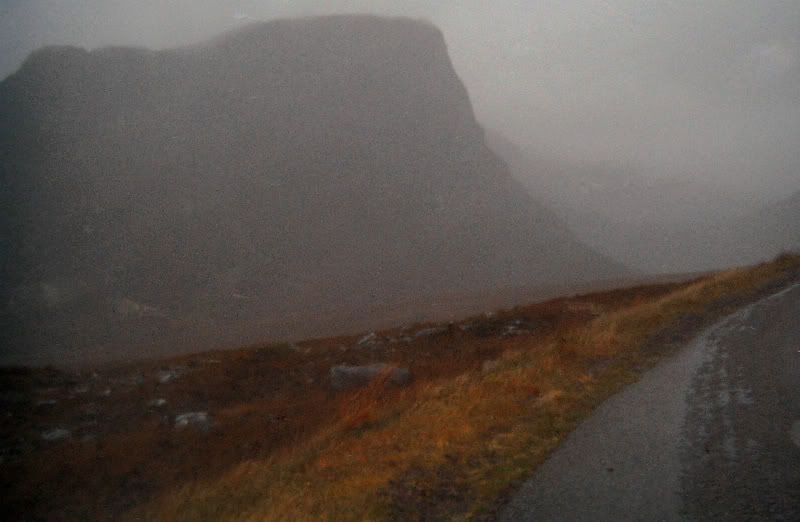
My first sight of the entrance to 'The Pass of the Cattle'
The road climbed urgently towards the cliff face, then onto the side of the cliff itself. To my right was a vertical rock wall, to my left, beyond the Armco barrier was a precipitous drop to the valley below. I peered into the gulf where a sullen-looking river coiled its way down the valley and disappeared into the mists. In the shadowy evening light, among the moaning winds and careless rain, the gloomy rock bastions and inhospitable valley took on an epic dimension. The scene looked like something out of the Lord of the Rings. It probably wasn’t as deep or as high as it seemed right then, but I was awestruck.
I followed the road for several miles, as far down towards Applecross as I dare go before coming back. Turning the bike about on the narrow, greasy and steeply inclined road proved to be a scary business and my heart was in my mouth more than once. I lost my footing as I rolled her back and nearly dropped her. It took everything I had to keep her upright. Journeying back over the pass, the view was, if anything, even more dramatic and impressive than before. The place looked vaster and grimmer then ever and even more mysterious in the still-fading light. It was a truly awesome spectacle, and I was spellbound by it - until that is, I had to pull over quickly for a little ice cream van beetling along the road in the opposite direction. Nothing could have broken the magic quite as comprehensively as that.
By the time I got back on the A896 it was nearly half past four and getting quite dark. The rain, fortunately, had stopped and the clouds had begun to disperse. The weather forecast which had predicted clear skies later in the afternoon hadn’t lied after all. Half past four is still afternoon I guess, even in winter, and if there had been a sun in the sky it would have come out now.
I didn’t want to be on minor roads when light finally went if I could help it, so I put on some speed. The A896’s pre-ordained turn to the east was only a mile or so beyond the Applecross road, but unfortunately, unlike its sister roads it then ran north-east, and I needed to go east and south. I followed it through the village of Lochcarron to beyond the headwaters, then turned west again on the A890 until it hit the A87. This was a major road which would take me all the way back to the Great Glen, and to the by-now-familiar Fort William Road, the A82. At Loch Carron, a sign told me I still had 85 miles to go to get back to the B&B. I had reckoned on 50. Oh Well!
Despite my tiredness, perhaps because of it, the night time ride was a hoot. The road was full of fast switchback sweepers, just made for a bike. I’ve found that it is harder to target fixate in the dark so I’m less prone to bottle it on corners when I’m tired. It was great fun. And it was dry but the dryness didn’t count for much because I was pretty much soaked anyway by the day’s rain and dampness. About an hour and a half later I rolled back up the drive into the B&B, wet and very, very achey. I collapsed into a chair for about ten minutes before I could even work up the energy to get out of my soaking wet gear and into something dry.
I shoved all the wet stuff close to the radiator, turned the heating on full, then, pocketing my door key, walked the quarter mile into town to the Highland Star Chinese Restaurant, the one I’d found on my first day here. It was warm and quiet, the food was good and, in my present mood, I could even enjoy the sentimental Scottish ballads that yearned out of the speakers. And there I spent a very decent couple of hours, eating an excellent evening meal, cosying down at a corner table and writing up my diary of the day’s events.
With food inside me, some good dry clothes on my back and a head full of the day’s journey, I was still in a very comfortable mood when I walked back along the lochside road to the B&B. And no doubt I would have gone to bed still in that very pleasant frame of mind had not a large Rover car driven through a puddle of standing water at the kerbside and drenched me once again from head to foot.



